Punch-through diode
a diode and punching technology, applied in the direction of diodes, semiconductor/solid-state device details, instruments, etc., can solve the problems of difficult to fabricate mim diodes having desirable properties, unipolar switching is possible, and unipolar operation may suffer
- Summary
- Abstract
- Description
- Claims
- Application Information
AI Technical Summary
Problems solved by technology
Method used
Image
Examples
Embodiment Construction
[0029]A punch-through diode and method of fabricating the same are disclosed herein. The punch-through diode may be used as a steering element in a memory device having memory cells with reversible resistivity-switching elements. For example, a memory cell may include a reversible resistivity-switching element in series with a punch-through diode. The punch-through diode allows bipolar operation of a cross-point memory array. The punch-through diode may have a symmetrical non-linear current / voltage relationship. The punch-through diode may have a high current at high bias for selected memory cells and a low leakage current at low bias for unselected memory cells. In other words, the ratio of Ion / Ioff may be high. Therefore, the punch-through diode is compatible with bipolar switching in cross-point memory arrays having resistive switching elements. However, note that embodiments of a punch-through diode disclosed herein may have other applications.
[0030]In one embodiment, the punch-...
PUM
 Login to View More
Login to View More Abstract
Description
Claims
Application Information
 Login to View More
Login to View More - R&D
- Intellectual Property
- Life Sciences
- Materials
- Tech Scout
- Unparalleled Data Quality
- Higher Quality Content
- 60% Fewer Hallucinations
Browse by: Latest US Patents, China's latest patents, Technical Efficacy Thesaurus, Application Domain, Technology Topic, Popular Technical Reports.
© 2025 PatSnap. All rights reserved.Legal|Privacy policy|Modern Slavery Act Transparency Statement|Sitemap|About US| Contact US: help@patsnap.com



